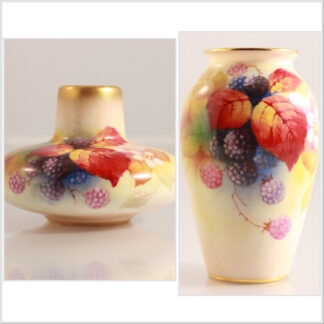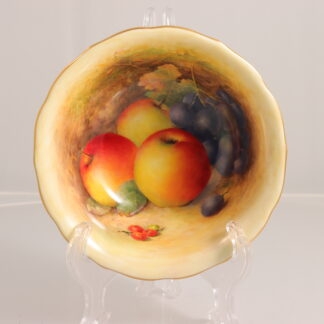Royal Worcester
Showing all 6 results
-

Very Rare Antique Pair of Japanese Style Porcelain Vases (English 19th Century 1877)
By Royal Worcester
$22,750.00 More InfoAdd to cart -

Original 1926 Gold Gilt landscape Scene Cabinet Plate With Stand By John Stinton “Corfe Castle”
By Royal Worcester
$2,200.00 More InfoAdd to cart -

Vintage Signed Kitty Blake Squat Vase / Vase Circa 1938
By Royal Worcester
$819.95 – $1,159.95 More Info Select options -

A Fine 19th Century Royal Worcester Griffin Handled Exhibition Vase by Edward Raby
By Royal Worcester England
$9,500.00 More InfoAdd to cart -

Rare Royal Worcester Bowl Decorated in Hand Painted Fruit by Richard Sebright
By Royal Worcester
$1,850.00 More InfoAdd to cart -

View All Our Items
More InfoRead more
Showing all 6 results
Royal Worcester Bio / Information
Royal Worcester, founded in 1751, stands as one of the oldest English porcelain brands today, possibly the second oldest, although Royal Crown Derby disputes this, asserting its establishment in 1750. Acquired by the Portmeirion Group in 2009, Royal Worcester thrives in luxury tableware and giftware, even as its Worcester production ceased.
Originally known as the Worcester Royal Porcelain Co. Ltd., Royal Worcester emerged in 1862. Despite holding a royal warrant from 1788, items pre-dating that period, along with those from two other Worcester factories, are termed Worcester porcelain. The brand mirrored the success of other English porcelain brands during the 18th and 19th centuries.
In the early 1750s, physicians John Wall and William Davis sought to create porcelain for economic growth in Worcester. Around 1750-1751, they encountered Lund and Miller, Bristol porcelain manufacturers using soap rock. Persuading 13 businessmen in 1751, Wall and Davis established a factory in Warmstry House, Worcester, marking the beginning of “The Worcester Tonquin Manufactory.” The original partnership deeds remain in the Museum of Worcester Porcelain.
Richard Holdship played a vital role, securing a soap rock license and facilitating the buyout of Lund’s Bristol porcelain factory in 1752. Worcester initially produced soft-paste porcelain with soap rock, aligning with Bristol’s methods. In 1783, Thomas Flight purchased the factory, and in 1788, it received a royal warrant from George III.
Under Thomas Flight’s sons, John and Joseph Flight, and partner Martin Barr, the factory faced challenges in the late 18th century. Competition from Chinese export porcelain and Thomas Turner’s Caughley Factory pressured production. Martin Barr Jr and George Barr prepared to take over, and in addition to George III’s warrant, royal warrants were granted by the Prince and Princess of Wales in 1807 and 1808, respectively.
“Worcester porcelain” includes hard-paste porcelain from Chamberlain’s Factory and Grainger’s Factory. Chamberlain’s Factory received a royal warrant in 1811. Grainger’s Factory, in operation since 1807, merged with the main Flight and Barr concern in 1840, continuing until Royal Worcester took over in 1889.
The Grainger & Co factory site at St Martin’s Gate operated from 1809 to 1902. The Museum of Royal Worcester, housing the world’s largest collection of Worcester porcelain, now stands at this location.
Notable porcelain painters and artists associated with Royal Worcester include Thomas Baxter, William Billingsley, Edward Raby, John Stinton, Harry Stinton, David Bates, James Hadley, Christopher Dresser, Charles Baldwin, Harry Davis, and Peter Ewence.
In the 20th century, “Evesham Gold” emerged as a popular pattern, depicting autumnal fruits. After the 1976 merger with Spode, production shifted to Stoke and other locations due to overseas competition. Facing challenges, staff reductions occurred in 2003 and 2005. The last trading date for Royal Worcester was on June 14, 2009. The company went into administration on November 6, 2008, and the brand name and intellectual property were acquired by Portmeirion Pottery Group on April 23, 2009. The purchase excluded the Royal Worcester and Spode manufacturing facilities.
Read more on Royal Worchester on Wikipedia.
Richard Sebright (1868-1951) Bio
Richard Sebright 1868-1951 was possibly the finest fruit painter of all time at the Royal Worcester factory working for the Worcester Establishment for over 5 decades Painters at the works were paid for each piece they produced the more they produced the more they were paid but Richard Sebright so determined that each piece he did would be the best that he could produce and refusing to cut corners in his work was never able to work fast enough to earn as much as many of the others did – Richard also Exhibited at the Royal Academy and noted for his Fine Floral Watercolours.
Kitty Blake
Worcester fruit artist Kitty Blake crafted various designs showcasing blackberries and buttercups. Kitty Worked at the Worcester factory for 48 years from 1905 until 1953
Kitty Blake had earlier worked at James Hadley’s factory in Diglis Road, and her Hadley-style depictions of blackberry bunches have become iconic Kitty Blake signature pieces.
These renditions are incredibly lifelike and highly coveted by collectors.
Similar to many renowned ceramic painters, Kitty Blake appears to come from an artistically gifted family; her brother Edward was employed at the Locke factory, painting Pheasants.
John Stinton (jnr) (1854–1956)
John Stinton (jnr) (1854–1956), a distinguished British ‘Royal Worcester’ painter, achieved fame for his captivating ‘Highland Cattle’ scenes.
For over 160 years, the Stinton family left an indelible mark on Worcester’s artistic legacy. The tradition commenced with Henry Stinton, engaged at the Grainger family’s St. Martins Gate factory in Worcester since 1805. Later, he became part of the esteemed ‘Royal Worcester’ group. John Stinton (snr), born in 1829 as Henry’s son, commenced his apprenticeship at the Grainger factory at eleven, serving until retirement in 1895. An accomplished artist, John (snr) discovered that oil of cloves preserved his paints. Fathering five sons, three embraced their artistic heritage, becoming painters at Worcester factories.
John Stinton, the eldest son, ventured into china painting at thirty-five. Renowned for ‘Highland Cattle,’ he also portrayed English cattle, crafted images of British castles, and painted numerous watercolour landscapes. If you look closely you will notice most of the cattle in his cattle scenes don’t have any feet, apparently he couldn’t paint feet very well and usually hid them in the grass. An avid gardener, he cultivated tobacco in a heated greenhouse for his pipe-smoking.
Following in their father’s footsteps, four of John Stinton (jnr)’s children pursued ceramic painting. Arthur Stinton, born in 1878, joined the Grainger factory post its amalgamation with Royal Worcester, later moving to the Locke factory. Annie Stinton (born 1882) joined Grainger and transitioned to Royal Worcester. Kate Stinton (born 1882) worked at Royal Worcester, while Harry Stinton (born 1883) painted Highland cattle scenes, overcoming childhood illness to become a respected figure since joining the firm in 1896.
